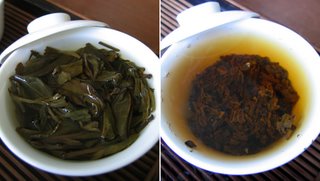
Dadugang 1999 Yiwu
Leaf:
Medium leaves, mostly whole, medium meat. drying by heated room.
Heated Leaf aroma:
Sweet / dried fruit.
Water temp: Crab/fish eye.
Infusion and ratio:
6g in 150ml gaiwan. brief rinse, 90s rests, 15s, 30s, 30s, 15s, 15s, 20s, 30s, 60s....
Liquor color:
Cloudy / golden yellow.
Flavor Notes:
Medium bitterness, chalky, mild flora and sweetness, and menthol, hint of camphor, woody hint of bamboo flavor, drying mouth. mild body. medium complexity.
Best Infusions:
Starting at 5th-8th.
Cha Qi:
Mild, relaxing.
Overall:
Is there a storage problem? too cloudy to start. A cultivated specimen? On the delicate side for a Yiwu.
Age-ability:
OK. lack of liquor clarity.
Would I buy this tea?: No.
Mang Shi 1999 Dehong Melon
Leaf:
Small leaves, mostly dusty, dry storage.
Heated Leaf aroma:
Sweet / wheat grains / straw.
Water temp: Crab/fish eye.
Infusion and ratio:
6g in 150ml gaiwan. brief rinse, 60s rests, 15s, 15s, 20s, 20s, 30s, 30s, 60s, 60s....
Liquor color:
Clear golden yellow / small hint of brown.
Flavor Notes:
Refreshing, sweetness with bites, hint of smoke, straw, floral aftertaste, medium body. medium smooth complexity.
Best Infusions:
Starting at 3rd onwards.
Cha Qi:
Welcoming and present.
Overall:
Mine look too young for a 6 years old? Good easy drinking.
Age-ability:
Good.
Would I buy this tea?: No.






















